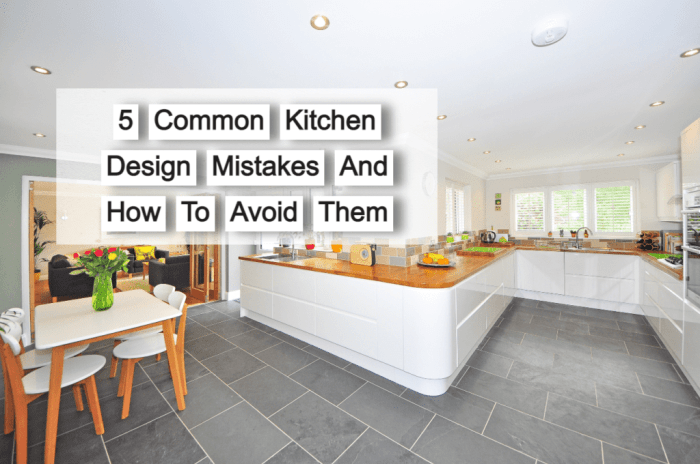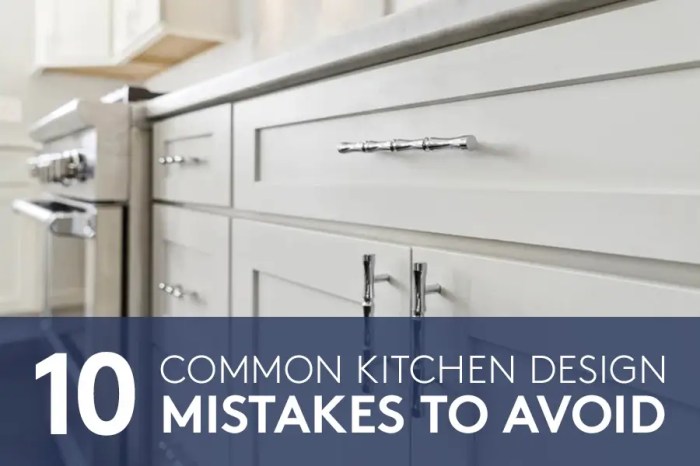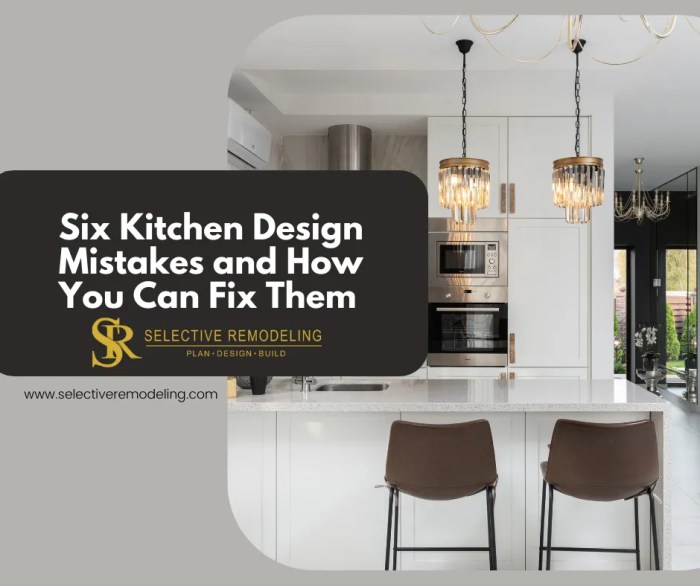Kitchen Design Mistakes to Avoid (and How to Fix Them) sets the stage for this enthralling narrative, offering readers a glimpse into a story that is rich in detail with casual formal language style and brimming with originality from the outset.
When it comes to designing a kitchen, there are common pitfalls that many homeowners fall into. From poor layout choices to inadequate storage solutions, understanding these mistakes can help you create a space that is both functional and visually appealing.
Common Kitchen Design Mistakes

When it comes to designing a kitchen, homeowners often make mistakes that can impact the functionality and overall appeal of the space. It is essential to consider both aesthetics and practicality to create a kitchen that is not only beautiful but also efficient and user-friendly.
Overlooking the Importance of Storage
One common mistake homeowners make is overlooking the importance of adequate storage in the kitchen. Insufficient storage space can lead to cluttered countertops, making it challenging to work efficiently in the kitchen. It is essential to incorporate enough cabinets, drawers, and pantry space to keep the kitchen organized and functional.
Ignoring Proper Lighting
Another mistake is ignoring proper lighting in the kitchen. Good lighting is crucial for various kitchen tasks, such as food preparation, cooking, and cleaning. Without adequate lighting, the kitchen can feel dim and unwelcoming. It is essential to incorporate a mix of task lighting, ambient lighting, and accent lighting to create a well-lit and inviting space.
Not Considering the Workflow
Many homeowners fail to consider the workflow when designing their kitchen layout. A poorly planned layout can make it challenging to move around the kitchen efficiently while preparing meals. It is crucial to create a functional workflow by placing key elements like the sink, stove, and refrigerator in a convenient and logical arrangement.
This will make cooking and cleaning tasks more manageable and enjoyable.
Poor Layout Choices

When it comes to kitchen design, the layout plays a crucial role in the overall functionality and efficiency of the space. Poor layout choices can hinder the workflow and make everyday tasks more challenging than they need to be.Open-concept kitchens have gained popularity in recent years for their spacious and airy feel.
However, this layout choice can sometimes lead to a lack of storage space and make it difficult to hide clutter. On the other hand, closed-off kitchen layouts offer more privacy and can help contain cooking smells, but they may feel cramped and disconnected from the rest of the living space.
Significance of the Kitchen Work Triangle
The kitchen work triangle is a design principle that optimizes the efficiency of the kitchen layout by ensuring a clear path between the three main work areas: the sink, the stove, and the refrigerator. This concept helps minimize unnecessary movement and maximizes the functionality of the space.
- Examples of layout choices that can hinder the efficiency of a kitchen include placing the refrigerator too far from the cooking area, creating obstacles between the sink and the stove, or not having enough counter space near the food preparation zone.
- Open-concept kitchens offer a seamless flow between the cooking, dining, and living areas, but they may lack designated zones for specific tasks, leading to a disorganized and cluttered space. Closed-off kitchen layouts, on the other hand, provide clear boundaries for each functional area but can feel isolated and limit natural light and airflow.
- The kitchen work triangle ensures that the three key work areas are easily accessible and in close proximity to each other, allowing for a smooth and efficient workflow. By adhering to this design principle, homeowners can create a functional and well-organized kitchen layout that enhances their cooking experience.
Inadequate Storage Solutions
Having sufficient storage in a kitchen is essential to maintain organization, functionality, and efficiency. Inadequate storage solutions can lead to clutter, difficulty in finding items, and overall chaos in the kitchen space.
Maximizing Space in a Small Kitchen
Small kitchens often struggle with limited storage space, but there are innovative solutions that can help maximize every inch:
- Utilize vertical space: Install shelves, racks, or hooks on walls to store pots, pans, and utensils.
- Opt for multi-functional furniture: Choose kitchen islands or tables with built-in storage compartments.
- Use the insides of cabinet doors: Install racks or hooks to hang small items like measuring spoons or kitchen towels.
Organizing Kitchen Cabinets and Drawers
Efficient organization of kitchen cabinets and drawers is key to maximizing storage space and maintaining order:
- Group similar items together: Keep baking supplies, spices, or utensils in designated areas for easy access.
- Use drawer dividers: Separate cutlery, cooking tools, and gadgets to prevent clutter and make items easier to find.
- Label containers and jars: Clearly mark containers to quickly identify contents and avoid confusion.
Improper Lighting

Proper lighting is crucial in kitchen design as it not only enhances the overall aesthetic appeal but also plays a key role in functionality and safety. Insufficient or improper lighting can make tasks like food preparation, cooking, and cleaning more challenging.
Types of Lighting and Their Roles
- Ambient Lighting: This provides overall illumination in the kitchen, ensuring there are no dark corners or shadows. It sets the general mood and ambiance of the space.
- Task Lighting: Task lighting is focused on specific work areas such as the countertop, stove, or sink. It helps in performing tasks efficiently and safely by providing adequate light where needed.
- Accent Lighting: Accent lighting is used to highlight certain features or areas in the kitchen, such as artwork, cabinets, or architectural details. It adds depth and visual interest to the space.
Suggestions for Improving Lighting
- Install under cabinet lighting to illuminate countertops and workspaces effectively without major renovations.
- Consider adding pendant lights above the kitchen island or dining area to create a focal point and enhance the overall lighting scheme.
- Utilize dimmer switches to adjust the brightness of the lights according to the time of day and specific tasks being performed.
- Maximize natural light by keeping windows clean and using light-colored window treatments to allow more sunlight to enter the space.
Ultimate Conclusion
In conclusion, navigating the world of kitchen design can be tricky, but by avoiding these common mistakes and implementing the right fixes, you can transform your kitchen into a space that is not only beautiful but also highly functional.
FAQ Insights
Why is proper lighting important in kitchen design?
Proper lighting is essential in a kitchen as it affects the ambiance, visibility, and functionality of the space. It can enhance safety, improve task performance, and create a welcoming atmosphere.
How can I maximize storage in a small kitchen?
To maximize storage in a small kitchen, consider using vertical space with tall cabinets, utilizing under-cabinet storage solutions, and decluttering regularly to make the most of the available space.













